一、先看下django的admin是如何做搜索功能的
配置一个search_fields的列表就可以实现搜索的功能
class testbook(admin.ModelAdmin):
# 第一步,定义一个函数,必须要接受三个参数
def test_action(self,request,queryset):
"""
:param request:
:param queryset:这个就是需要批量操作的queryset对象
:return:
"""
print(queryset)
# 第二步,为这个函数对象赋值一个新的属性
test_action.short_description = "测试批量操作的函数"
# 第三步,将函数对象添加到actions这个列表中
actions = [test_action]
list_filter = ["auther","publist"]
search_fields = ["auther","title"]
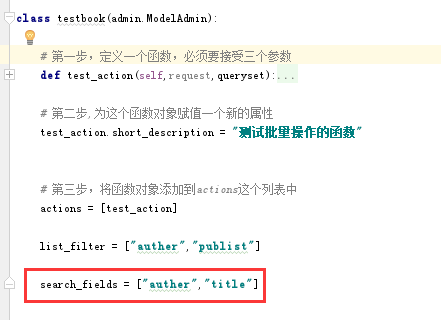
看下页面的效果,这里就可以通过auther或者title进行搜索了
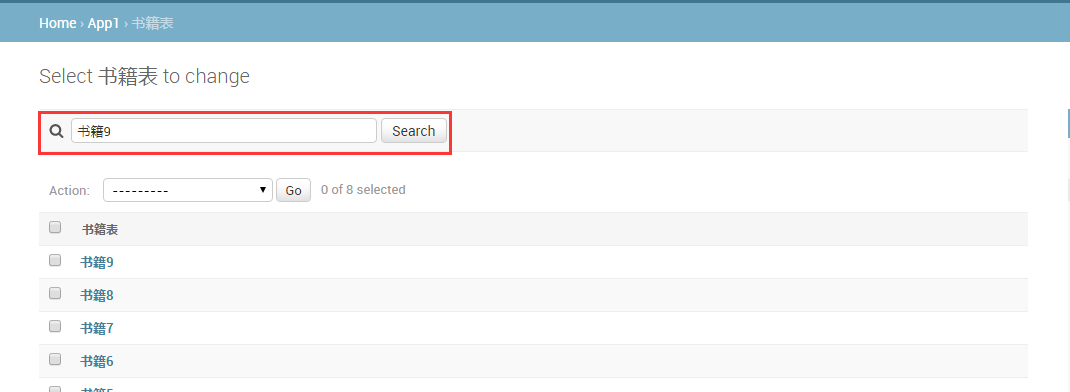
二、下面看下我们的stark组件是如何做搜索的
1、首先我们也在自己的配置类里定义一个search_field的搜索字段
class bookclass(stark.Starkclass):
list_display = ["id","title","price","auther","publish"]
list_display_links = ["id","price","auther"]
search_fields = ["title","price"]
def test_action(self,request,queryset):
print(queryset,)
actions = [test_action]
# test_action.__name__ = "测试批量操作的函数"
test_action.short_description = "测试批量操作的函数"
modelformclass = mybookmodelform
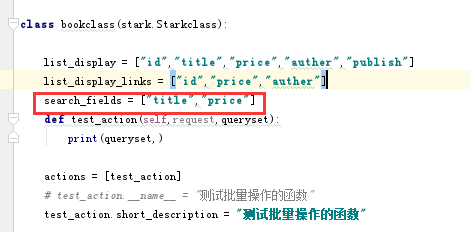
2、同样,我们还需要在父类中定义一个search_field字段,为了防止客户未定义search_field字段和报错
class Starkclass(object):
list_display = ['__str__']
list_display_links = []
search_fields = []
modelformclass = None
actions = []
list_filter = []
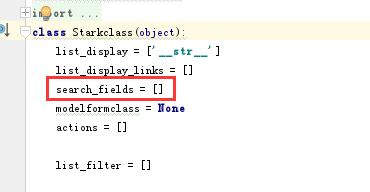
3、然后我们看下具体的代码
这里我们先简单的说一下思路,我们默认会显示所有的数据,那么,如果我们加了一个搜索的字段,那么我们中就加一个参数,这个参数的k就是search,v就是我们输入的值,
这样后端拿到搜索的字段后,就可以使用Q查询做or的匹配,然后显示出过滤后的信息就可以了
def list_url(self,request):
import importlib
if request.method == "POST":
func = request.POST.get("func")
action_list = request.POST.getlist("selectpk")
action_func = getattr(self,func)
queryset = self.model.objects.filter(id__in=action_list)
action_func(request,queryset)
new_list = self.create_new_display()
q_obj = self.get_search(request)
q_filter_obj = self.get_filter(request)
if q_obj and q_filter_obj:
new_data_list = self.model.objects.all().filter(q_obj).filter(q_filter_obj)
elif q_obj and not q_filter_obj:
new_data_list = self.model.objects.all().filter(q_obj)
elif not q_obj and q_filter_obj:
new_data_list = self.model.objects.all().filter(q_filter_obj)
else:
new_data_list = self.model.objects.all()
showlist = Showlist(self, request, new_list,new_data_list)
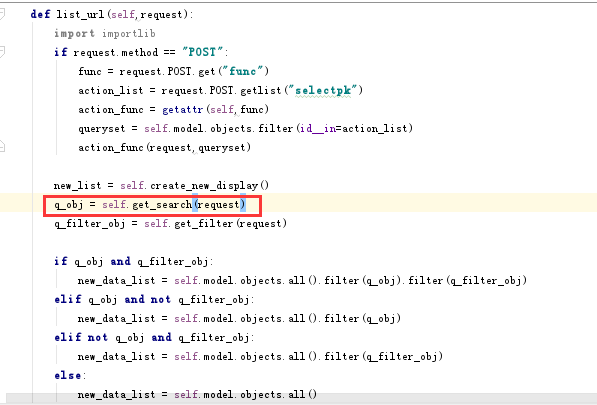
通过get_search函数去获取过滤的信息
4、下面我们看下get_search函数的代码
def get_search(self,request):
from django.db.models import Q
search_str = request.GET.get("search", None)
if search_str:
if self.search_fields:
q_obj = Q()
q_obj.connector = "or"
for field in self.search_fields:
q_obj.children.append((field + "__icontains", search_str))
return q_obj
else:
return None
else:
return None
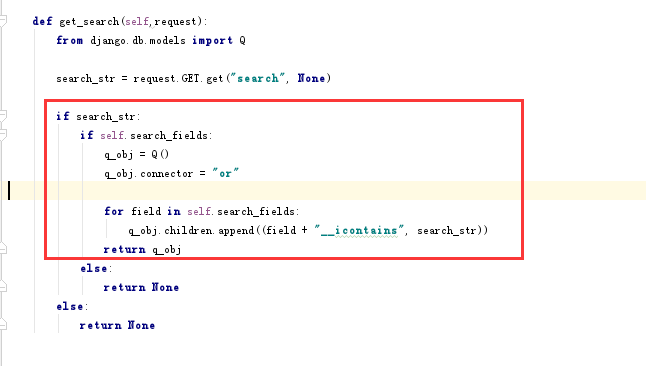
获取到search的字段,然后做q查询,最终返回一个q对象
5、list_url函数拿到返回的Q对象,然后做过滤,将过滤后的信息传递给showlist这个类,在来显示
def list_url(self,request):
import importlib
if request.method == "POST":
func = request.POST.get("func")
action_list = request.POST.getlist("selectpk")
action_func = getattr(self,func)
queryset = self.model.objects.filter(id__in=action_list)
action_func(request,queryset)
new_list = self.create_new_display()
q_obj = self.get_search(request)
q_filter_obj = self.get_filter(request)
if q_obj and q_filter_obj:
new_data_list = self.model.objects.all().filter(q_obj).filter(q_filter_obj)
elif q_obj and not q_filter_obj:
new_data_list = self.model.objects.all().filter(q_obj)
elif not q_obj and q_filter_obj:
new_data_list = self.model.objects.all().filter(q_filter_obj)
else:
new_data_list = self.model.objects.all()
showlist = Showlist(self, request, new_list,new_data_list)
title_list = showlist.get_header()
data_list = showlist.get_body()
page_str = showlist.get_page()
action_str = showlist.get_actions()
get_filter = showlist.get_filter_link_tag()
return render(request,"list_view.html",{"data_list":data_list,"title_list":title_list,"page_str":page_str,"search_fields":self.search_fields,"action_str":action_str,
"get_filter":get_filter
})
重点是看这里
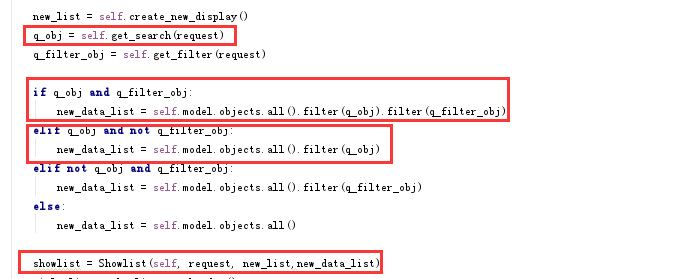
然后我们在看下showlist的类
class Showlist(object):
def __init__(self,config,request,new_list,new_data_list):
self.config = config
self.request = request
self.new_list = new_list
self.new_data_list = new_data_list
# 分页显示
count = self.new_data_list.count()
current_page = int(request.GET.get("p",1))
per_page_num = 3
base_url = request.path_info
parms = request.GET
self.page_str = page.page_helper(count=count,current_page=current_page,per_page_num=per_page_num,base_url=base_url,parms=parms)
def get_body(self):
from django.db.models import Q
new_list = self.new_list
data_list_obj = self.new_data_list[self.page_str.db_start() - 1:self.page_str.db_end() - 1]
data_list = []
for obj in data_list_obj:
temp_list = []
for i in new_list:
if not callable(i):
if self.config.list_display_links:
if i in self.config.list_display_links:
# i_obj = obj._meta.get_field(i)
# print(type(i_obj),"i_obj",i)
from django.db.models.fields.related import ManyToManyField
i_obj = obj._meta.get_field(i)
if isinstance(i_obj,(ManyToManyField,)):
many = getattr(obj, i)
many_query_set = many.all()
temp = ""
for o in many_query_set:
temp = temp + str(o) + "&"
temp = temp.rstrip("&")
else:
temp = getattr(obj,i)
app_name = obj._meta.app_label
model_name = obj._meta.model_name
edit_path = "/stark/{app}/{model}/edit/{eid}".format(app=app_name, model=model_name, eid=obj.id)
temp = mark_safe("<a href='{path}'>{link}</a>".format(link=temp,path=edit_path))
else:
from django.db.models.fields.related import ManyToManyField
i_obj = obj._meta.get_field(i)
if isinstance(i_obj,(ManyToManyField,)):
many = getattr(obj, i)
many_query_set = many.all()
temp = ""
for o in many_query_set:
temp = temp + str(o) + "&"
temp = temp.rstrip("&")
else:
temp = getattr(obj, i)
else:
temp = getattr(obj,i)
else:
temp = i(self,obj)
temp_list.append(temp)
data_list.append(temp_list)
return data_list
返回过滤后的数据
6、最后我们看下页面的代码,如果有search_field字段,页面才显示,如果没有则不会显示
{% if search_fields %}
<form class="pull-right" method="get">
<input type="text" name="search" placeholder="搜索"><input type="submit" value="搜索">
</form>
{% endif %}
这里我们用form表单发get请求,进行搜索,之间我们都是用form表单发送post请求,其实form表单也可以发get请求,这是我们不常用而已

7、页面效果如下





